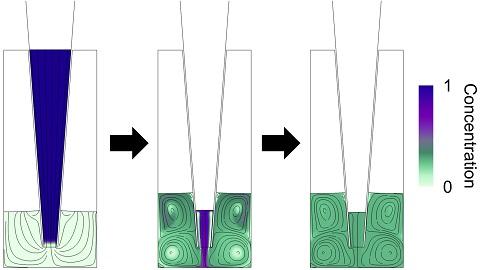Veryst regularly performs multiphysics analyses in a large number of industries. Multiphysics involves the analysis of multiple, simultaneous physical phenomena. These simultaneous phenomena can include heat transfer, fluid flow, deformation, electromagnetics, acoustics, and mass transport. Despite the complexity involved in the coupling, multiphysics is essential for many applications where traditional single-physics analyses are inadequate to account for the simultaneity of real events and processes.
Veryst’s consultants employ grounded knowledge of computational methods, mechanics, and physics to provide practical multiphysics solutions. Veryst is a COMSOL Certified Consultant, and we use COMSOL Multiphysics in a wide variety of applications and industries, combining the physical processes of fluid flow, stress analysis, heat transfer, nonlinear materials, contact, vaporization and condensation, acoustics, microwave heating, gas dynamics, and mixing. For more details, contact us at multiphysics@veryst.com.
Individual Physics Expertise
Expertise
- Fluid flow
- Thermal analysis
- Species transport
- Electromagnetics
- Structural mechanics
- Acoustics
- Chemical reactions
- Nonlinear systems
Applications
- Medical devices
- MEMS and sensors
- Consumer products
- Pneumatic and hydraulic systems
- Renewable energy
- Industrial processes and systems
- Aerospace
- Automotive
Multiphysics Expertise
We work extensively in solving multiphysics problems, including fluid-structure interactions, electromagnetic heating, thermal-structure coupling, conjugate heat transfer, and structural-acoustic vibrations.
We use multiphysics modeling to provide value to our clients by helping them understand and optimize product performance, perform proof of concept investigations and, in some cases, generate new intellectual property. We stress the importance of testing and validation for all our modeling efforts, especially multiphysics modeling due to the complexity and interdisciplinary nature of the models.
Fluid–Structure Interaction (FSI)
Fluid-structure interaction refers to analyses involving fluid flow and solid deformation. Depending on the problem, the interaction may be along a shared boundary or internal to the structure as in the case of poroelasticity. In addition to the solid and fluid deformation, FSI requires handling a moving mesh. Read more about fluid-structure interaction.
Thermal–Structure Coupling
Thermal-structure coupling involves simultaneous heat transfer and stress or deformation analysis. Heat transfer can include radiation, conduction, and convection, and the stress analysis can involve nonlinear processes such as contact, nonlinear materials, and large deformations.
Structural–Acoustic Interaction
Simulating the vibration response of coupled fluid-structure problems involving small deformations is best performed by modeling the fluid using a pressure acoustic or a linearized Navier-Stokes formulation. This enables frequency domain and eigenvalue analyses, and more efficient time-domain analysis. Typical applications include vibration analysis of acoustic devices such MEMS transducers and hearing aids, and vehicle noise and vibration analysis.
Non-isothermal Flows
Modeling convective flow requires coupling fluid-flow with heat transfer. The coupled processes can be very complex, particularly if the fluid flow includes turbulence or if the heat transfer involves processes such as boiling, evaporation, or mixed fluids with varying thermal properties. Read more about non-isothermal flows.
Electromagnetic–Structural Coupling
Forces on structures resulting from an electromagnetic field require accurate evaluation of the electromagnetic field and the structural deformation. Two common forms are electrostatic forces, for example in MEMS switches, and magnetostatic forces, for example in solenoids and motors.
Electromagnetic Heating
Heat generated from electric and/or magnetic fields can be highly nonlinear. Processes governing electromagnetic heating include Joule heating and inductive heating where the permittivity and conductivity can be temperature-dependent. Joule heating in conductive materials is due to the generation of ohmic losses, whereas inductive heating is due to the generation of eddy currents.









